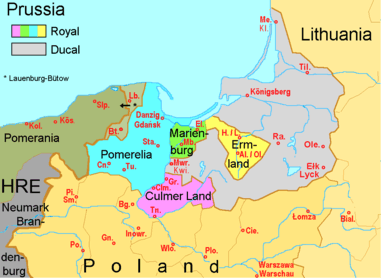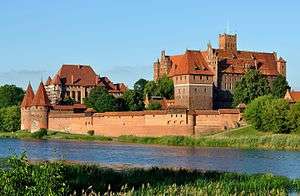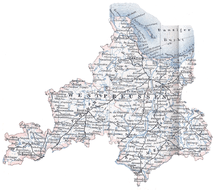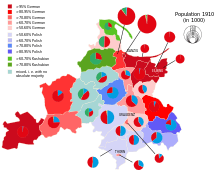West Prussia
The Province of West Prussia (German: Provinz Westpreußen; Kashubian: Zôpadné Prësë; Polish: Prusy Zachodnie) was a province of Prussia from 1773 to 1829 and 1878 to 1922. West Prussia was established as a province of the Kingdom of Prussia in 1773, formed from Royal Prussia of the Polish-Lithuanian Commonwealth annexed in the First Partition of Poland. West Prussia was dissolved in 1829 and merged with East Prussia to form the Province of Prussia, but was re-established in 1878 when the merger was reversed and became part of the German Empire. From 1918, West Prussia was a province of the Free State of Prussia within Weimar Germany, losing most of its territory to the Second Polish Republic and the Free City of Danzig in the Treaty of Versailles. West Prussia was dissolved in 1922, and its remaining western territory was merged with Posen to form Posen-West Prussia, and its eastern territory merged with East Prussia as the Region of West Prussia district.
| Province of West Prussia Provinz Westpreußen | |||||||||||||||
|---|---|---|---|---|---|---|---|---|---|---|---|---|---|---|---|
| Province of Prussia | |||||||||||||||
| 1773–1829 1878–1922 | |||||||||||||||
 Flag
 Coat of arms
| |||||||||||||||
.svg.png) West Prussia (red), within the Kingdom of Prussia, within the German Empire, as of 1878. | |||||||||||||||
| Anthem | |||||||||||||||
| Westpreußenlied | |||||||||||||||
| Capital | Marienwerder (1773–1793, 1806–1813) Danzig (1793–1806, 1813–1919) | ||||||||||||||
| Area | |||||||||||||||
• 1910 | 25,534 km2 (9,859 sq mi) | ||||||||||||||
| Population | |||||||||||||||
• 1910 | 1703474 | ||||||||||||||
| History | |||||||||||||||
• Established | 1773 | ||||||||||||||
• Division by Napoleon | 1806 | ||||||||||||||
• Restored | 1815 | ||||||||||||||
• Province of Prussia | 1824–1878 | ||||||||||||||
| 1919 | |||||||||||||||
• Disestablished | 1922 | ||||||||||||||
| Political subdivisions | Danzig Marienwerder | ||||||||||||||
| |||||||||||||||
| Today part of | |||||||||||||||
West Prussia's provincial capital alternated between Marienwerder (present-day Kwidzyn, Poland) and Danzig (Gdańsk, Poland) during its existence.
West Prussia was notable for its ethnic and religious diversity due to immigration and cultural changes, with the population becoming mixed over the centuries. Since the early Middle Ages the region was inhabited by numerous Slavic and Baltic peoples, such as Pomeranians in the Pomerelia region, Old Prussians and Masovians in Kulmerland, and Pomesanians east of the Vistula River. Later Germans followed. Germans were also the largest group in West Prussia until its dissolution in 1922, with large numbers of Kashubians, Poles, Mennonites, and Jews also settling in the region.
History
Context


In the Thirteen Years' War (1454–1466), the towns of the Prussian Confederation in Pomerelia and the adjacent Prussian region east of the Vistula River rebelled against the rule of the Teutonic Knights and sought the assistance of King Casimir IV Jagiellon of Poland. By the Second Peace of Thorn in 1466, Pomerelia and the Prussian Culm (Chełmno) and Marienburg (Malbork) lands as well as the autonomous Prince-Bishopric of Warmia (Ermland) became the Polish province of Royal Prussia, which received special rights, especially in Danzig (Gdańsk). The province became a Land of the Polish Crown within the Polish–Lithuanian Commonwealth (Rzeczpospolita) by the 1569 Union of Lublin. Parts of the local population objected to the Union as being a biased and unlawful interpretation of the incorporation privilege of 1454.[1]
East Prussia around Königsberg, on the other hand, remained with the State of the Teutonic Knights, who were reduced to vassals of the Polish kings. Their territory was secularised to the Duchy of Prussia according to the 1525 Treaty of Kraków. Ruled in personal union with the Imperial Margraviate of Brandenburg from 1618, the Hohenzollern rulers of Brandenburg-Prussia were able to remove the Polish suzerainty by the 1657 Treaty of Wehlau. This development turned out to be fatal to the Polish monarchy, as the two parts of the rising Kingdom of Prussia were separated by Polish land.
Establishment
In the 1772 First Partition of Poland the Prussian king Frederick the Great took the occasion to annex most of Royal Prussia. The addition gave Prussia a land connection between the Province of Pomerania and East Prussia, cutting off the Polish access to the Baltic Sea and rendering East Prussia more readily defensible in the event of war with the Russian Empire. The annexed voivodeships of Pomerania (i.e. Pomerelia) except for the City of Danzig, Marienburg (Polish: Malbork) and Kulm (Polish: Chełmno) (except for Thorn; Polish: Toruń) were incorporated into the Province of West Prussia the following year, while Ermland (Polish: Warmia) became part of the Province of East Prussia. Further annexed areas of Greater Poland and Kuyavia in the south formed the Netze District. The Partition Sejm ratified the cession on 30 September 1773. Thereafter Frederick styled himself "King of Prussia" rather than "King in Prussia."
The Polish administrative and legal code was replaced by the Prussian system, and 750 schools were built from 1772-1775.[2] Both Protestant and Roman Catholic teachers taught in West Prussia, and teachers and administrators were encouraged to be able to speak both German and Polish. Frederick II of Prussia also advised his successors to learn Polish, a policy followed by the Hohenzollern dynasty until Frederick III decided not to let William II learn Polish.[2] Despite this, Frederick II (Frederick the Great) looked askance upon many of his new citizens. In a letter from 1735, he calls them "dirty" and "vile apes"[3] He had nothing but contempt for the szlachta, the numerous Polish nobility, and wrote that Poland had "the worst government in Europe with the exception of Ottoman Empire".[4] He considered West Prussia less civilized than Colonial Canada[5] and compared the Poles to the Iroquois.[4] In a letter to his brother Henry, Frederick wrote about the province that "it is a very good and advantageous acquisition, both from a financial and a political point of view. In order to excite less jealousy I tell everyone that on my travels I have seen just sand, pine trees, heath land and Jews. Despite that there is a lot of work to be done; there is no order, and no planning and the towns are in a lamentable condition."[6] Frederick invited German immigrants to redevelop the province,.[2][7] Many German officials also regarded the Poles with contempt.[5] According to the Polish historian Jerzy Surdykowski, Frederick the Great introduced 300,000 German colonists.[8] According to Christopher Clark, 54 percent of the annexed area's and 75 percent of the urban population were German-speaking Protestants.[9] Further Polish areas were annexed in the Second Partition of Poland in 1793, now including the cities of Danzig (Gdańsk) and Thorn (Toruń). Some of the areas of Greater Poland annexed in 1772 that formed the Netze District were added to West Prussia in 1793 as well.
After the defeat of Prussia by the Napoleonic French Empire at the 1806 Battle of Jena-Auerstedt, West Prussia lost its southern territory in the vicinity of Thorn and Culm (Chełmno) to the short-lived Duchy of Warsaw, it also lost Danzig, which was a Free City from 1807 until 1814. After the final defeat of Napoleon in 1815, Danzig, Kulm, and Thorn were returned to West Prussia by resolution of the Vienna Congress.
Restoration
In 1815, the province was administratively subdivided into the Regierungsbezirke Danzig and Marienwerder. From 1824-1878 West Prussia was combined with East Prussia to form the Province of Prussia, after which they were reestablished as separate provinces. In 1840, King Frederick William IV of Prussia sought to reconcile the state with the Catholic Church and the kingdom's Polish subjects by granting amnesty to imprisoned Polish bishops and re-establishing Polish instruction in schools in districts having Polish majorities. However, after the region became part of the German Empire in 1871 during the unification of Germany, it was subjected to measures aimed at Germanization of Polish-speaking areas. The Polish historian Andrzej Chwalba cites Germanization measures that included:
- Ethnic Germans were favoured in government contracts and only they won them, while Poles always lost.[10]
- Ethnic Germans were also promoted in investment plans, supply contracts.[10]
- German craftsmen in Polish territories received the best locations in cities from authorities so that they could start their own business and prosper.[10]
- Soldiers received orders that banned them from buying in Polish shops and from Poles under the threat of arrest.[10]
- German merchantmen were encouraged to settle in Polish territories.[10]
- Tax incentives and beneficial financial arrangements were proposed to German officials and clerks if they would settle in Polish inhabited provinces.[10]
In the German census of 1910, the population of West Prussia was put at 1,703,474, of whom around 64 percent listed their first language as German, 28 percent Polish and 7 percent Kashubian. According to Polish authors the real share of Poles and Kashubians was 43% (rather than 35.5% as in official figures), but many of them were counted as Catholic Germans by Prussian census clerks.[11]
Dissolution
In 1910, ethnic Poles were between 36% and 43% of West Prussia's populace.[11] After the Treaty of Versailles in 1919, most of pre-war West Prussia's territory (62%) and population (57%, the majority of whom were Polish) was granted to the Second Polish Republic or the Free City of Danzig (8% of territory, 19% of population), while parts in the west (18% of territory, 9% of population) and east (12% of territory, 15% of population) of the former province remained in Weimar Germany.[12] The western remainder formed Grenzmark Posen-West Prussia in 1922, while the eastern remainder became part of Regierungsbezirk West Prussia within East Prussia.
The region was invaded, then included in the Reichsgau Danzig-West Prussia within Nazi Germany during World War II and settled with 130,000 German colonists,[13] while between 120,000 and 170,000 Poles and Jews were removed by the Germans through expulsion, massacres, enslavement or killed in extermination camps.[14] As in all other areas, Poles and Jews were classified as "Untermenschen" by the German state, with their fate being slavery and extermination. Later in the war, many West Prussian Germans fled westward as the Red Army advanced on the Eastern Front. All of the areas occupied by Nazis were restored to Poland according to the post-war Potsdam Agreement in 1945, along with further neighbouring areas of former Nazi Germany. The vast majority of the remaining German population of the region which had not fled before was subsequently expelled westward. Many German civilians were deported to labor camps like Vorkuta in the Soviet Union, where a large number of them perished or were later reported missing. In 1949, the refugees established the non-profit Landsmannschaft Westpreußen to represent West Prussians in the Federal Republic of Germany.
| West Prussia | Area in 1910 in km2 | Share of territory | Population in 1910 | After WW1 part of: | Notes |
|---|---|---|---|---|---|
| Given to: | 25,580 km2 [15] | 100% | 1.703.474 | Divided between: | |
| Poland | 15,900 km2 [15] | 62% [16] | 57% [16] | Pomeranian Voivodeship | [Note 1] |
| Free City Danzig | 1,966 km2 | 8% | 19% | Free City of Danzig | |
| East Prussia | 2,927 km2 | 11% | 15% | Region of West Prussia | [Note 2] |
| Germany | 4,787 km2 | 19% | 9% | Posen-West Prussia [17] | [Note 3] |
Historical population


Legend for the districts:
Perhaps the earliest estimations on ethnic or national structure of West Prussia are from 1819. At that time West Prussia had 630,077 inhabitants, including 327,300 Poles (52%), 290,000 Germans (46%) and 12,700 Jews (2%).[19]
| Ethnic group | Population | |
|---|---|---|
| Number | Percentage | |
| Poles (Polen) | 327,300 | 52% |
| Germans (Deutsche) | 290,000 | 46% |
| Jews (Juden) | 12,700 | 2% |
| Total | 630,077 | 100% |
Karl Andree, "Polen: in geographischer, geschichtlicher und culturhistorischer Hinsicht" (Leipzig 1831), gives the total population of West Prussia as 700,000 – including 50% Poles (350,000), 47% Germans (330,000) and 3% Jews (20,000).[20]
The population more than doubled during the next seven decades, reaching 1,433,681 inhabitants (including 1,976 foreigners) in 1890. From 1885 to 1890 West Prussia's population decreased by 1%.
- 1875 – 1,343,057
- 1880 – 1,405,898
- 1890 – 1,433,681 (717,532 Catholics, 681,195 Protestants, 21,750 Jews, others)
- 1900 – 1,563,658 (800,395 Catholics, 730,685 Protestants, 18,226 Jews, others)
- 1905 – 1,641,936 (including 437,916 Polish speakers, 99,357 Kashubian speakers)[21]
- 1910 – 1,703,474 (including between 36% and 43% Poles, depending on source)[11]
According to the German census of 1910, in areas that became Polish after 1918, 42 percent of the populace were Germans (including German military, officials and colonists), while the Polish census of 1921 found 19 percent of Germans in the same territory.[22]
Contemporary sources in late 19th and early 20th centuries gave the number of Kashubians between 80,000–200,000.[23]
Subdivisions
Note: Prussian provinces were subdivided into districts called Kreise (singular Kreis, abbreviated Kr.). Cities would have their own Stadtkreis (urban district) and the surrounding rural area would be named for the city, but referred to as a Landkreis (rural district).
Population according to the German census 1905:
| Kreis (district) | Polish Name | Population 1905 | Polish, Kashubian | in Percent | German | in Percent |
| Regierungsbezirk Danzig | ||||||
| Elbing-Stadt | Elbląg | 55,627 | 175 | 0.31 | 55,328 | 99.46 |
| Elbing-Land | Elbląg | 38,871 | 105 | 0.27 | 38,737 | 99.66 |
| Marienburg | Malbork | 63,110 | 1,705 | 2.70 | 61,044 | 96.73 |
| Danzig-Stadt (City) | Gdańsk | 160,090 | 3,065 | 1.91 | 154,629 | 96.59 |
| Danzig-Niederung (lowland) | Gdańsk | 36,519 | 178 | 0.49 | 36,286 | 99.36 |
| Danziger Höhe (highland) | Gdańsk | 50,148 | 5,703 | 11.73 | 44,113 | 87.97 |
| Dirschau | Tczew | 40,856 | 15,144 | 37.07 | 25,466 | 62.33 |
| Preußisch Stargard | Starogard Gdański | 62,465 | 44,809 | 71.73 | 17,425 | 27.90 |
| Berent | Kościerzyna | 53,726 | 29,898 | 55.65 | 23,515 | 43.77 |
| Karthaus | Kartuzy | 66,612 | 46,281 | 69.48 | 20,203 | 30.33 |
| Neustadt | Wejherowo | 55,587 | 27,358 | 49.22 | 27,048 | 48.66 |
| Putzig | Puck | 25,701 | 17,906 | 69.67 | 7,629 | 29.68 |
| Total for Danzig Region | 709,312 | 192,327 | 27.11 | 511,423 | 72.10 | |
| Regierungsbezirk Marienwerder | ||||||
| Stuhm | Sztum | 36,559 | 13,473 | 36.85 | 22,550 | 61.68 |
| Marienwerder | Kwidzyn | 68,096 | 24,541 | 36.04 | 42,699 | 62.70 |
| Rosenberg | Susz | 53,293 | 3,465 | 6.50 | 49,304 | 92.51 |
| Löbau | Lubawa | 57,285 | 45,510 | 79.44 | 11,368 | 19.84 |
| Strasburg | Brodnica | 59,927 | 38,507 | 64.26 | 21,008 | 35.06 |
| Briesen | Wąbrzeźno | 47,542 | 25,415 | 53.46 | 21,688 | 45.62 |
| Thorn-Stadt (City) | Toruń | 43,658 | 13,988 | 32.04 | 29,230 | 66.59 |
| Thorn-Land | Toruń | 58,765 | 30,833 | 52.47 | 27,508 | 46.81 |
| Kulm | Chełmno | 49,521 | 25,659 | 51.89 | 23,521 | 47.50 |
| Graudenz-Stadt (City) | Grudziądz | 39,953 | 4,421 | 11.07 | 30,709 | 76.86 |
| Graudenz-Land | Grudziądz | 46,509 | 19,331 | 41.56 | 26,888 | 57.81 |
| Schwetz | Świecie | 87,151 | 47,779 | 54.82 | 39,276 | 45.07 |
| Tuchel | Tuchola | 30,803 | 20,540 | 66.68 | 9,925 | 32.22 |
| Konitz | Chojnice | 59,694 | 32,704 | 54.79 | 26,581 | 44.50 |
| Schlochau | Człuchów | 66,317 | 10,180 | 15.35 | 55,981 | 84.41 |
| Flatow | Złotów | 67,783 | 18,002 | 26.56 | 49,167 | 72.54 |
| Deutsch Krone | Wałcz | 63,706 | 653 | 1.03 | 62,977 | 98.86 |
| Total for Marienwerder Region | 936,562 | 375,001 | 40.04 | 550,380 | 58.77 | |
| Total for West Prussia | 1,645,874 | 567,328 | 34.47 | 1,061,803 | 64.51 | |
Office holders
See also
References
- Friedrich Borchert. Burgenland Preußen (in German). pp. 113–114.
- Koch, p. 136
- Przegląd humanistyczny, Tom 22, Wydania 3–6 Jan Zygmunt Jakubowski Państwowe Wydawn. Naukowe, 2000, page 105
- Ritter, p. 192
- David Blackbourn. "Conquests from Barbarism": Interpreting Land Reclamation in 18th Century Prussia. Harvard University. Accessed 24 May 2006.
- MacDonogh, p. 363
- Norbert Finszch and Dietmar Schirmer. Identity and Intolerance: Nationalism, Racism, and Xenophobia in Germany and the United States. Cambridge University Press, 2006. ISBN 0-521-59158-9
- Duch Rzeczypospolitej Jerzy Surdykowski - 2001 Wydawn. Nauk. PWN, 2001, page 153
- Christopher M. Clark (2006). Iron Kingdom: the rise and downfall of Prussia, 1600-1947. Harvard University Press. p. 233. ISBN 978-0-674-02385-7.
- Andrzej Chwalba, Historia Polski 1795-1918, pp. 461-463
- Kozicki, Stanislas (1918). The Poles under Prussian rule. London: Polish Press Bur. p. 5.
- Nadobnik, Marcin (1921). "Obszar i ludność b. dzielnicy pruskiej [Area and population of the former Prussian territory]" (PDF). AMUR - Adam Mickiewicz University Repository (in Polish).
- Bogdan Chrzanowski: Wypędzenia z Pomorza. Biuletyn IPN nr 5/2004, May 2004.
- WYSIEDLENIA Z ZIEM ZACHODNICH RZECZYPOSPOLITEJ W OKRESIE OKUPACJI NIEMIECKIEJ doctor Andrzej Gąsiorowski Stutthof Museum
- Weinfeld, Ignacy (1925). Tablice statystyczne Polski: wydanie za rok 1924 [Poland's statistical tables: edition for year 1924]. Warsaw: Instytut Wydawniczy "Bibljoteka Polska". p. 2.
- Nadobnik, Marcin (1921). "Obszar i ludność b. dzielnicy pruskiej [Area and population of former Prussian district]" (PDF). Ruch Prawniczy, Ekonomiczny i Socjologiczny. Poznań. 1 (3) – via AMUR - Adam Mickiewicz University Repository.
- "Die Grenzmark Posen-Westpreußen Übersichtskarte". Gonschior.de.
- A history of eastern Europe: crisis and change Robert Bideleux, Ian Jeffries page 180, Routledge; 1st edition 1998 ""It systematically Germanicized "eastern" place names and public signs, fostered German cultural imperialism, and provided financial and other inducements for German farmers, officials, clergy, and teachers to settle and work in the east. After Bismarck's fall in 1890, Kaiser Wilhelm II actively encouraged all this. Not only did he provide large benefactions..."
- Hassel, Georg (1823). Statistischer Umriß der sämmtlichen europäischen und der vornehmsten außereuropäischen Staaten, in Hinsicht ihrer Entwickelung, Größe, Volksmenge, Finanz- und Militärverfassung, tabellarisch dargestellt; Erster Heft: Welcher die beiden großen Mächte Österreich und Preußen und den Deutschen Staatenbund darstellt. Verlag des Geographischen Instituts Weimar. p. 42.
- Andree, Karl (1831). Polen: in geographischer, geschichtlicher und culturhistorischer Hinsicht. Verlag von Ludwig Schumann. p. 212.
- Zeno. "Westpreußen". www.zeno.org. Retrieved 19 March 2018.
- http://web.ku.edu/~eceurope/hist557/lect11_files/11pic2.jpg
- Kilka słów o Kaszubach i ich mowie (in Polish)
Notes
- Poland received several cities and counties of West Prussia located east of the Vistula: Lubawa, Brodnica, Wąbrzeźno, Toruń, Chełmno, Grudziądz; as well as most of cities and counties of West Prussia located west of it: Świecie, Tuchola, Starogard Gdański, Kwidzyn (only part west of the Vistula), most of county Tczew, eastern part of county Złotów, part of county Człuchów, as well as counties Chojnice, Kościerzyna, Kartuzy, coastal Wejherowo and Puck with Gdynia; as well as a small western part of Danziger Höhe and areas around Janowo east of the Vistula.
- Parts of West Prussia east of Nogat and Vistula rivers which remained in Germany after 1918, including the city and county of Elbląg and counties Malbork (part east of Nogat), Sztum, Kwidzyn (only part east of the Vistula) and Susz, were incorporated to East Prussia as the Regency of West Prussia. The area of historical Pomesania had significant Polish minority.
- Western part of West Prussia with county Wałcz and parts of counties Złotów and Człuchów (the latter two split between Poland and Germany). This area included 12 towns and cities: Człuchów, Debrzno, Biały Bór, Czarne, Lędyczek, Złotów, Krajenka, Wałcz, Mirosławiec, Człopa, Tuczno and Jastrowie. The area was home to significant Polish minority.
External links
- Blanke, Richard (1993). Orphans of Versailles. The University Press of Kentucky. p. 316. ISBN 0-8131-1803-4.
- Koch, H. W. (1978). A History of Prussia. New York: Barnes & Noble Books. p. 326. ISBN 0-88029-158-3.
- MacDonogh, Giles (2001). Frederick the Great: A Life in Deed and Letters. New York: St. Martin's Griffin. p. 436. ISBN 0-312-27266-9.
- Ritter, Gerhard (1974). Frederick the Great: A Historical Profile. Berkeley: University of California Press. p. 207. ISBN 0-520-02775-2.
- de Zayas, Alfred-Maurice (1994). A Terrible Revenge: The Ethnic Cleansing of the Eastern European Germans 1944-1950. New York: St. Martin's Press.
- Rota, Andrea (2010). Wiedersehen mit der Familie, Wiedersehen in der Heimat. SÖHNE von Volker Koepp. In Elena Agazzi, Erhard Schütz (Ed.): Heimkehr: eine zentrale Kategorie der Nachkriegszeit. Geschichte, Literatur und Medien. Berlin: Duncker & Humblot. p. 257-268. ISBN 978-3-428-53379-4
External links
| Wikimedia Commons has media related to West Prussia. |
| Wikisource has the text of the 1911 Encyclopædia Britannica article West Prussia. |